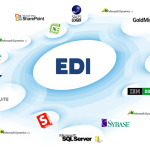BizTalk: thoughts on B2B (BAM, BAS, EDI, Rosetta)
 BAS are meant to be used by business people, and not by developers, it makes sense to expose them through familiar tools.
BAS are meant to be used by business people, and not by developers, it makes sense to expose them through familiar tools.- BAS = BAM + TPM + BPC + BPP
- TPM: Establishing connections requires agreeing on several things
- Common protocol
- Format messages
- Process that will derive business.
- BPC: Business process configuration helps information workers to configure if they need.
- Role Links: Using their notion, a BP can be abstracted from a specific implementation by labeling set of input & output operations constituting buyer role or seller role. At time of deployment, this generic BP can be specialized, enlisting a particular buyer or particular seller and configuring the inputs required.
- BAM: provides visibility into business process independent of IT implementation. One can view business data in real time, with ‘zero latency’. BAM let us separate performances in KPI ( key performance indicators ) and show in an aggregated for relative analysis.
-formal def : “real-time visibility into a running business process with little or no impact on performance of process for both biztalk and non-biztalk applications, by leveraging existing BI technologies to aggregate and analayze data from heterogenous event sources presenting a single real-time view of business current state, trends, and critical success factors.” hurts my head. L - BAM: A bam view relies on one or more activities. A BAM activity represents a specific business process, such as handling purchase order.
Developer must configure orchestration using tracking profile editor ( TPE ) to provide info bam activity. - Scenarios suitable for BAM: a typical order-management process, can be complex enough for business user to put their arms around.
- Why BAM? main goal is to connect info worker to back-end servers, using desktop tools, in a flexible way. Second one, is to provide services to analyze, aggregate and display business event data with as little custom code and impact on running business process as is possible.
- BAM Addin: allows to create observation model or wish list of data in form of activities and views. Data defined is abstractly associated with business process and is in no way associated with physical implementation.
- TPE: BAM activity and view data, when ready, is exported to BAM definition xml file using BAM excel add-in. The file is then imported by a developer into tool called Tracking profile editor. TPE allows developers to map aggregations and KPIs to actual process.
– Trackign profile needs to be deployed, sending mappings to biztalk mgmtDb. btt.exe tool can be used to do this.
– BM.exe: accepts bam excel sheet, to provision sql assets required to track the real-time and historical data. Data can be viewed in file_livedata.xls - BAM definition workbook: analysts uses BAM activity wizard to specify what data to collect and how to interpret it, this is called BAM view. This is save excel workbook called BAM definition workbook.
- BAM Manager: is responsible for creating all the assets required for real-time or OLAP storage. Several of these tables are in PIT database i.e. Primary Import database. BAM manager uses the KPIs and aggregations defined in BAM XML definition file to create these tables as well as DTS packages required for archival and data maintenance.
- Event Observation Layer: When it receives an event, it creates a new the record in PIT database ( bam_<activityname>_Active ). It keeps updating that record as long as activity as active. When activity is complete, it will mark it as completed and fire a trigger that then moves the record to “bam_<ActivityName>_Completed” table.
Related Posts
Comment (1)
Comments are closed.







Rober Rose
December 1, 2014Reading this article, I haven’t a clue what any of the acronyms (BAS, BAM, TPC, etc.) mean. I can make an educated guess from the discussion about the acronym, but having no reference point, the article has no meaning for me.
A rule of thumb in journalism:
Whenever using acronyms in an article, never assume anyone besides yourself knows the meaning of the acronym. Always, the first time you use an acronym, provide its meaning even if you provided an explanation in a previous article.
There are two ways to do this in an article of this sort.
Example 1: BPC (Business Process Configuration)…
Example 2: Business Process Configuration (BAM)…